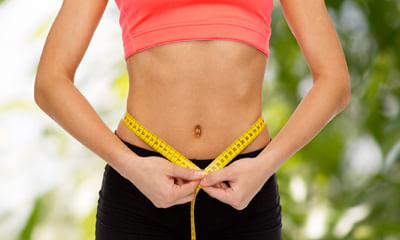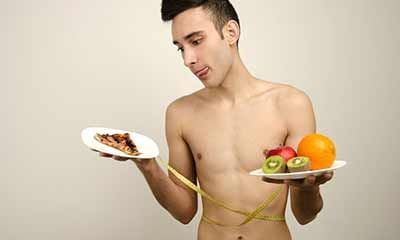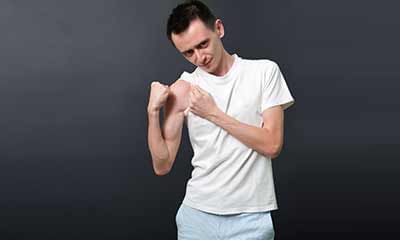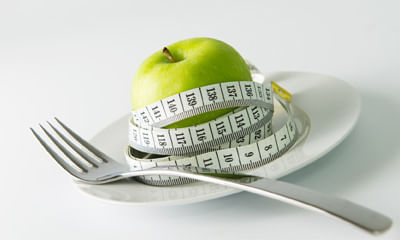What Causes Fat Around Waist
Does eating carbohydrates and foods high in fat as well as sugar lead to excess belly fat? Is belly fat worse than regul ...
Ask Free Question
Hi, Ideal waist for indian women is< 32 inches, men < 35 inches. Fat at the abdomen and visceral fat is quite harmful as it is close to all vital organs of your body this is most harmful compared to the fat located in any other part of your body. Excess carbohydrates like sugars in excess are converted to fat.
Meri age 50 main diabetes paisent hu mujhe erectile dysfunction ki problem ho rahi hai main sex nahi kar pa raha hu half ...
Ask Free Question
Erectile dysfunction occurs due to heart disease, clogged blood vessels (atherosclerosis), high cholesterol. High blood pressure, diabetes, obesity, metabolic syndrome — a condition involving increased blood pressure, high insulin levels, body fat around the waist and high cholesterol. I can help you to get rid of it through proper counseling, guidelines and medication, consult us online.
How can one recover from penile dysfunction after getting it as a result of frequently masturbating. ...
Ask Free Question
Start walking. according to one harvard study, just 30 minutes of walking a day was linked with a 41% drop in risk for ed. Other research suggests that moderate exercise can help restore sexual performance in obese middle-aged men with ed. Eat right. in the massachusetts male aging study, eating a diet rich in natural foods like fruit, vegetables, whole grains, and fish — with fewer red and processed meat and refined grains — decreased the likelihood of ed. pay attention to your vascular health. high blood pressure, high blood sugar, high cholesterol, and high triglycerides can all damage arteries in the heart (causing heart attack), in the brain (causing stroke), and leading to the penis (causing ed). An expanding waistline also contributes. Check with your doctor to find out whether your vascular system — and thus your heart, brain, and penis — is in good shape or needs a tune-up through lifestyle changes and, if necessary, medications. Size matters, so get slim and stay slim. a trim waistline is one good defense — a man with a 42-inch waist is 50% more likely to have ed than one with a 32-inch waist. Losing weight can help fight erectile dysfunction, so getting to a healthy weight and staying there is another good strategy for avoiding or fixing ed. Obesity raises risks for vascular disease and diabetes, two major causes of ed. And excess fat interferes with several hormones that may be part of the problem as well. Move a muscle, but we're not talking about your biceps. a strong pelvic floor enhances rigidity during erections and helps keep blood from leaving the penis by pressing on a key vein. In a british trial, three months of twice-daily sets of kegel exercises (which strengthen these muscles), combined with biofeedback and advice on lifestyle changes — quitting smoking, losing weight, limiting alcohol — worked far better than just advice on lifestyle changes. ●yes it can be permanently cured with homeopathy treatment.●very effective medicines are there in homeopathic ●with my treatment of 1 month you will get permanent relief. ●will prescribe the complete treatment ●you can consult me now through online take care.
Thank you sir for your response I wanted to just know that is ashwagandha effective in building fat mass. ...
Ask Free Question
I am sorry to hear about your concern but will be happy to assist you. Ashwagandha helps in reducing muscle wasting related to stress. It does not lead to weight gain. Let's connect over a call so that we can discuss your concern in details and make a suitable treatment plan for you.
Mera size thik h near about 6 inch but please patla h bahut like me am also slim 50 weight 5.6 hight nd 28 waist. ...
Ask Free Question
Hi, ideal weight for your height is about 65 kgs. You need to gain about 10-15 kgs. 1)weight is a sum total of bone, water, muscle and fat. You need to gain muscle to get healthy. Immunity of the body is based on muscles and so its important to have optimal muscle mass. 2)have a well balanced diet which has the right combination of carbohydrate, protein and fat. 3)eat 6-8 meals a day as the muscle losses will not happen. 4)have carbohydrate and protein rich food combinations like banana or mango milkshake, mix nuts and dryfruit chikkis, soya or paneer veg rolls etc. 5)include high biological value proteins which are very well absorbed like- milk, curd, paneer, meat, fish, eggs etc. 6)include essential fats like almonds, walnut, pistachios, flaxseeds etc. 7)eat on waking up and do have a bed time meal like milk and light snack. 8)do not fast or overeat as this will not help. 9)hydrate optimally by having a glass of water every hour to flush out toxins and prevent weight loss due to dehydration. 10)sleep of 9-10 hours is very crucial to gain muscle and weight.
Hello good evening, I am nelson am 19 years old. I have been feeding fine but I am not adding weight, only my face is ad ...
Ask Free Question
U can try this - 1. 1. Don't take tea empty stomach. Eat something like a banana (if you are not diabetic). Or any seasonal fruit or soaked almonds and a glass of water first thing in the morning (within 10 mins of waking up). No only biscuits or rusk will not do. 2. Don't drink water before meals. This can fill your stomach and make it harder to get in enough calories. 3. Take your breakfast every day. Don't skip it. U can eat whatever your mother or grandparent eat in bfast. I mean to say whatever is your traditional food. If punjabi eat paratha, if belongs to south then take idli/ dosa etc. 4. Have light meals every 2 hours (in addition to your breakfast, lunch n dinner) e.g. Nariyal paani, chaach, a handful of dry fruits (eat whole fruit not juice), a handful of peanuts, seasonal fruit, a cup of curd/milk, a cheese cube/slice/ banana shake etc 5. Finish your dinner at least 2 hours before going to sleep. Take simple food like rice n dal in dinner. 7.take a lot of green vegetables n fruit. 8. Drink lot of water9. Everyday preferably sleep on same time 10. Maintain active life style. Exercise to gain weight swimming:jogging:lunges and squats:bench press:deadlifts:yoga:pull-ups:upright barbell rows and dumbbell shoulder press lifting weight is important too, so that the additional calories can be used to build muscle instead of just adding fat. 11. Don't smoke. Smokers tend to weigh less than non-smokers, and quitting smoking often leads to weight gain.
Hi, I have 36 yrs, 1st time 2019 my uric acid was 8.1 and huge pain my right leg, now I have uric acid 8.9 but slight pa ...
Ask Free Question
People of any age, back pain can affect or different reasonsas people get older, the chance of developing lower back pain increases, due to factors such as previous occupation and degenerative disk disease. Lower back pain may be linked to the bony lumbar spine, discs between the vertebrae, ligaments around the spine and discs, spinal cord and nerves, lower back muscles, abdominal and pelvic internal organs, and the skin around the lumbar area. •acute pain starts suddenly and lasts for up to 6 weeks. •chronic or long-term pain develops over a longer period, lasts for over 3 months, and causes ongoing problems. Home advise: •resting from strenuous activity can help, but moving around will ease stiffness, reduce pain, and prevent muscles from weakening. •applying heat, ice, ultrasound, and electrical stimulation — as well as some muscle-release techniques to the back muscles and soft tissues — may help alleviate pain. •as the pain improves, the physical therapist may introduce some flexibility and strength exercises for the back and abdominal muscles. Techniques for improving posture may also help. •the patient will be encouraged to practice the techniques regularly, even after the pain has gone, to prevent back pain recurrence. Regular exercise helps build strength and control body weight. Guided, low-impact aerobic activities can boost heart health without straining or jerking the back. Before starting any exercise program, talk to a health care professional. There are two main types of exercise that people can do to reduce the risk of back pain: •core-strengthening exercises work the abdominal and back muscles, helping to strengthen muscles that protect the back. •flexibility training aims at improving core flexibility, including the spine, hips, and upper legs. We suggest you to wear lumbosacral corset (belt) which is available at our clinic. If you want you can buy from us, if you are far away from chennai we can send you by courier. The reason why we are conveying you to buy from us is we can demonstrate over the videocall (using whatsapp) and also we can monitor you throughout when to wear it and how long to wear it. And also if you find any difficulty wearing the brace you can also revert back to us for few more suggestions and we can propose you good solution how to go about it. Uses of lumbosacral corset (belt) a lumbosacral corset adds pressure to the intra-abdominal area. This adds stability to the spine. It is prescribed to people suffering from moderate to severe pain. Other benefits of using a lumbar spine belt are: 1.helps in a certain degree of immobilization of facet joints. 2.reduces pain to allow continuation of normal activities. 3.speeds up the healing process. 4.the pressure exerted by a lumbar spine belt helps in stretching the erector spine muscles. 5.this belt can also be used to support the lower back while exercising. Ohelps prevent rolling oprovides stability to lumbar and sacral regions of the back ocan be used when performing actions like lifting and handling heavy items ocan also be used when playing sports orestricts back movement to aid treatment of back problems do’s and don’ts sitting do: • sit as little as possible and then only for short periods. • place a supportive towel roll at the belt line of the back especially when sitting in a car. • when getting up from sitting, keep the normal curves in your back. Move to the front of the seat and stand up by straightening your legs. Avoid bending forward at the waist. • try to keep the normal curves in your back at all times. Don’t: • do not sit on a low soft couch with a deep seat. It will force you to sit with your hips lower than your knees and will round your back. You will loose the normal curve in your back. • do not place your legs straight out in front of you while sitting (e.g. Sitting in the bath tub). Standing do: • if you must stand for a long period of time, keep one leg up on a foot stool. • adapt work heights. Don’t: • avoid half bent positions. Lifting avoid lifting if you can. Do: • use the correct lifting technique. Keep your back straight when lifting. Never stoop or bend forward. Stand close to the load, have a firm footing and wide stance. Kneel on one knee, keeping the back straight. Have a secure grip on the load and lift by straightening your knees. Do a steady lift. Shift your feet to turn and do not twist your back. Don’t: • do not jerk when you lift. • do not bend over the object you are lifting. Lying do: • sleep on a good firm surface. • if your bed sags, use slats or plywood supports between the mattress and base to firm it. You also can place the mattress on the floor, a simple but temporary solution. • you may be more comfortable at night when you use a pillow for support. Don’t: • do not sleep on your stomach unless advised to do so by your doctor or physical therapist. Bending forward do: • keep the natural curves of your back when doing these and other activities: making a bed, vacuuming, sweeping or mopping the floor, weeding the garden or raking leaves. Coughing and sneezing do: • bend backwards to increase the curve of your back while you cough or sneeze. Driving a car do: • drive the car as little as possible. It is better to be a passenger than to drive yourself. • move the seat forward to the steering wheel. Your seat must be close enough to the wheel to keep the natural curves of your back. If your hips are lower than your knees in this position, raise yourself by sitting on a pillow. Exercises for low back pain safety guidelines • an increase in your low back pain can be expected with these exercises. This is acceptable as long as your leg symptoms are not increasing. • if while doing these exercises, your pain worsens or you have new pain or symptoms, stop the exercises and discuss your symptoms with your doctor or physical therapist. • stop exercising and let your doctor or physical therapist know right away if you have any change in your bowel or bladder control or any increase in weakness in your leg or foot. Exercises ‰ •press-ups: keep your back and buttocks relaxed and use your arms to press up. Concentrate on keeping your hips down and push up your upper body as high as possible. •double knee to chest: grasp both your knees with your hands and pull toward your shoulders. Hold the stretch for 1 second. Let your knees return, but keep them bent at arms length. ‰ •lumbar spine stretches: lie on your back. Bring your knees towards your chest. Rotate your knees towards the pain. •side-lying position: lie on your side and face forward. Have both arms straight in front and bend your knees. Turn your head as you move your top arm across your body as far as you can. Keep your arm in place and turn your head back to the starting position. Look back again and turn your head farther if you can. Bring your head and arm back to the starting position. Relax and repeat 10 times on each side. •hamstring stretch: lie on your back with your legs out straight. Raise your leg up and put your hands around the upper leg for support. Slowly straighten the raised knee until you feel a stretch in the back of the upper leg. Hold, then relax and repeat 10 times on each leg. •standing arch: stand with your feet apart and hands on the small of your back with fingers pointing backwards. Bend backwards at the waist, supporting the trunk with your hands. Keep your knees straight. Hold for 5 seconds. Repeat 3 to 5 times. Side glides: stand at a right angle to the wall about 2 feet o eliminate your pain improve your muscular endurance and strength attain better posture, balance, body awareness and co-ordination improve your balance and flexibility learn to lift properly. posture when standing: make sure you have a neutral pelvic position. Stand upright, head facing forward, back straight, and balance your weight evenly on both feet. Keep your legs straight and your head in line with your spine. Posture when sitting: a good seat for working should have good back support, arm rests and a swivel base. When sitting, try to keep your knees and hips level and keep your feet flat on the floor, or use a footstool. You should ideally be able to sit upright with support in the small of your back. If you are using a keyboard, make sure your elbows are at right-angles and that your forearms are horizontal. Shoes: flat shoes place less of a strain on the back. Driving: it is important to have proper support for your back. Make sure the wing mirrors are properly positioned so you do not need to twist. The pedals should be squarely in front of your feet. If you are on a long journey, have plenty of breaks. Get out of the car and walk around. Bed: you should have a mattress that keeps your spine straight, while at the same time supporting the weight of your shoulders and buttocks. Use a pillow, but not one that forces your neck into a steep angle.
I am a 17 year old boy I have stretch marks on my arms and waist and thighs can you tell me how to remove these. ...
Ask Free Question
Hi lybrate-user stretch marks arise due to stretching of skin and the underlying fat and subcutaneous tissue is seen superficially. We have developed a wonderful skin serum for it. It is based of moringa oil and helps in toning of skin besides nourishing it. If you are interested for a direct consultation, please book an appointment slot with me. The product can be shipped to you if you like. Best regards Dr. Danny devasy.
I am 17-18 years old, my height is about 165 cm but my weight is too low about 45 kgs, less waist, my face seems to be s ...
Ask Free Question
Hi, ideal weight for your height is 55-58 kgs. Follow the guidelines below- 1) weight is a sum total of bone, water, muscle and fat. You need to gain muscle to get healthy. Immunity of the body is based on muscles and so its important to have optimal muscle mass. 2)have a well balanced diet which has the right combination of carbohydrate, protein and fat. 3)eat 6-8 meals a day as the muscle losses will not happen. 4)have carbohydrate and protein rich food combinations like banana or mango milkshake, mix nuts and dryfruit chikkis, soya or paneer veg rolls etc. 5)include high biological value proteins which are very well absorbed like- milk, curd, paneer, meat, fish, eggs etc. 6)include essential fats like almonds, walnut, pistachios, flaxseeds etc. 7)eat on waking up and do have a bed time meal like milk and light snack. 8)do not fast or overeat as this will not help. 9)hydrate optimally by having a glass of water every hour to flush out toxins and prevent weight loss due to dehydration. 10)sleep of 9-10 hours is very crucial to gain muscle and weight.
I am 66. After tripping down and falling, my yoga and gym activities came to a halt. I have gathered fat around my waist ...
Ask Free Question
You can start with moderate carbohydrate and high fibre diet. Add seasonal fruits and vegetables in your diet. Take plenty of water during the day. Proper sleep is must. You can also start with meditation and alovera juice after that. For specific pattern you can take diet properly.









